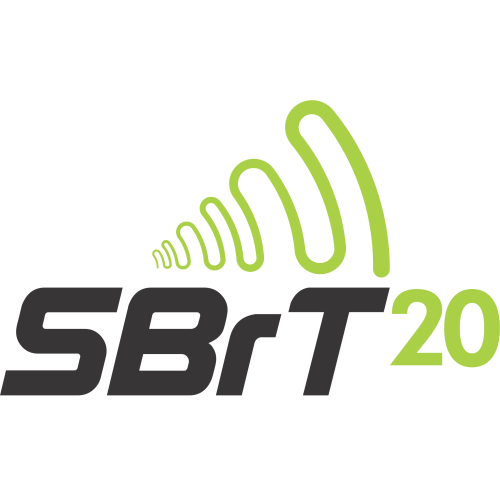
XXXVIII Simpósio Brasileiro de Telecomunicações e Processamento de Sinais

General Purpose Radar Simulator based on Blender Cycles Path Tracer
Rômulo Fernandes da Costa, Diego da Silva de Medeiros, Raíssa Andrade, Osamu Saotome, Renato Machado
DOI: 10.14209/SBRT.2020.1570649487
Keywords: Radar signals 3D modeling RGB channel modulation
Abstract
This paper proposes a general-purpose radar simulation tool based on the path tracer Cycles used in Blender, an open-source 3D computer graphics software. The scenarios, object's geometry, and materials can be defined within Blender. The propagation of waves in the scenery is simulated by the Cycles renderer, so that a second computational tool, such as Matlab or Octave, can be used for reconstructing the received signal. A simulated experiment using the proposed tool is presented. The results indicate that the tool has a great potential to be used in a variety of radar applications, including cross-section measurement, simulated radar data generation, and simulated synthetic aperture radar imaging.Download
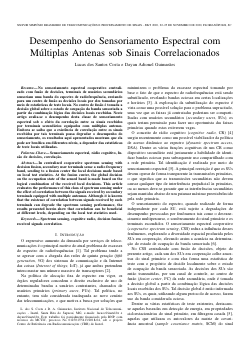
Desempenho do Sensoriamento Espectral com Múltiplas Antenas sob Sinais Correlacionados
Lucas dos Santos Costa, Dayan A. Guimarães
DOI: 10.14209/SBRT.2020.1570649488
Keywords: Spectrum sensing cognitive radio decision fusion received signals correlation
Abstract
In centralized cooperative spectrum sensing with decision fusion, secondary user terminals sense a radio frequency band, sending to a fusion center the local decisions made based on local test statistics. At the fusion center, the global decision on the occupation state of the sensed band is made based on the logical combination of the received local decisions. This article evaluates the performance of this class of spectrum sensing under the effect of correlation between the signals received by secondary terminals equipped with multiple antennas. Although it is known that the existence of correlation between signals received by such terminals can degrade the spectrum sensing performance, the results presented herein show that correlation can be beneficial at different levels, depending on the local test statistics used.Download
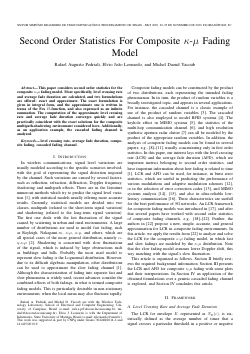
Second Order Statistics For Composite κ-μ Fading Model
Rafael Augusto Pedriali, Elvio J Leonardo, Michel Daoud Yacoub
DOI: 10.14209/SBRT.2020.1570649499
Keywords: level crossing rate average fade duration composite fading cascaded fading channel
Abstract
This paper considers second order statistics for the composite κ-μ fading model. More specifically, level crossing rate and average fade duration are calculated, and two formulations are offered: exact and approximate. The exact formulation is given in integral form, and the approximate one is written in terms of the Fox H-function, and also expressed as an infinite summation. The computation of the approximate level crossing rate and average fade duration converges quickly and are practically coincident with the exact solutions for the composite multipath-shadowing environment considered here. Additionally, as an application example, the cascaded fading channel is analyzed.Download

High-SNR Second-Order Statistics of Amplify-and-Forward Relaying with Variable Gains and Multiple Hops
Reginaldo Nunes de Souza, Edgar Eduardo Benitez Olivo, Lucas Catão de Freitas Ferreira, Carlos R. N. da Silva, José Cândido Silveira Santos Filho
DOI: 10.14209/SBRT.2020.1570649504
Keywords: amplify-and-forward variable-gain LCR AFD
Abstract
We analyze the high-SNR behavior of the level crossing rate and average fade duration for a variable-gain amplify-and-forward relaying system composed of an arbitrary number of hops under Rayleigh fading. Most studies on the second-order statistics of multi-hop amplify-and-forward relaying assume fixed gains at the relays and analyze the end-to-end channel gain (from source to destination). Such analysis leads to the so-called cascaded product channel, being mathematically attractive, yet ignoring the accumulation of noise along the hops. Here, in turn, we take the noise into account by analyzing the end-to-end SNR, which ultimately governs the system performance. Also, aiming at the benchmark for transparent relaying, we assume variable gains at the relays. We obtain simple closed-form asymptotic expressions for the investigated second-order statistics and, as a byproduct, for the associated outage probability.Download
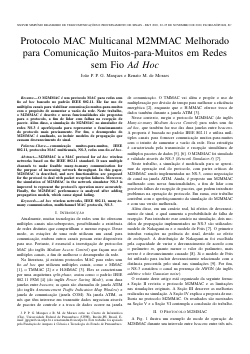
Protocolo MAC Multicanal M2MMAC Melhorado para Comunicação Muitos-para-Muitos em Redes sem Fio Ad Hoc
João Paulo Pinto Galdino Marques, Renato M. de Moraes
DOI: 10.14209/SBRT.2020.1570649518
Keywords: Ad hoc wireless networks MAC protocols Many-to-many communication Multichannel protocols
Abstract
M2MMAC is a MAC protocol for ad hoc wireless networks based on the IEEE 802.11 standard. It uses multiple channels to make feasible many-to-many communication for the purpose of increasing network throughput. In this paper, M2MMAC is described, and new functionalities are proposed for the protocol to deal with packet reception failures. Moreover, the simulation of M2MMAC in the network simulator NS-3 is improved to represent the protocol's operation more accurately. Finally, the M2MMAC performance is analyzed after adding propagation models, which cause signal fading.Download
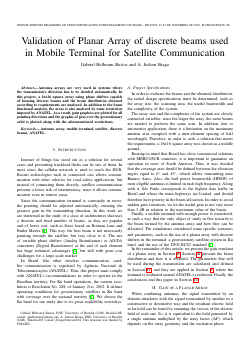
Validation of Planar Array of discrete beams used in Mobile Terminal for Satellite Communication
Gabriel H Bastos, Adoniran Judson Braga
DOI: 10.14209/SBRT.2020.1570649521
Keywords: Antenna array mobile terminal satellite discrete beams
Abstract
Antenna arrays are very used in system that the transmission's direction has to be decided automatically. In this project, a 16x16 square array using phase shifters capable of forming discrete beams and the beam distribution obtained according to requirements are analyzed. In addition to the beam functional analysis, the array is also analyzed by some restriction imposed by ANATEL. As a result, gain graphics are plotted for all pointing directions and the graphic of gain over the geostationary orbit is plotted along with the aforementioned restrictions.Download

Mitigation of nonlinear phase noise in coherent 16-QAM long-reach PONs by K-nearest neighbors-based classification
Rômulo de Paula, Lucio Borges, Marcelo Abbade, Ivan A Aldaya
DOI: 10.14209/SBRT.2020.1570649603
Keywords: Coherent optical communications Passive optical networks Nonlinear phase noise K-nearest neighbors
Abstract
Nonlinear phase-noise induced by the Kerr effect is the main nonlinear impairment in single-channel coherent long-reach passive optical networks (LR-PONs). In this work, we explore the capability of the K-nearest neighbors (KNN) algorithm to mitigate this impairment in links with non-negligible fiber dispersion. Simulation results show that when employing KNN in a 56-Gbps coherent LR-PON with a 100-km range and 1:64 splitting ratio, the effective Q-factor is improved by 0.15 dB with respect to maximum likelihood. This increment is achieved by setting the parameter K to 13, which leads to a minimum training data set size of 500 symbols.Download
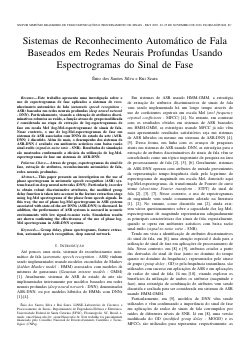
Sistemas de Reconhecimento Automático de Fala Baseados em Redes Neurais Profundas Usando Espectrogramas do Sinal de Fase
Ênio Silva, Rui Seara
DOI: 10.14209/SBRT.2020.1570649609
Keywords: Atraso de grupo Espectrogramas do sinal de fase Extração de atributos Reconhecimento automático de fala
Abstract
Este trabalho apresenta uma investigação sobre o uso de espectrogramas de fase aplicados a sistemas de reconhecimento automático de fala (automatic speech recognition - ASR) baseados em redes neurais profundas (deep neural network - DNN). Particularmente, visando à obtenção de atributos discriminativos robustos ao ruído, a função atraso de grupo modificada é considerada na etapa de extração de log-espectrogramas de fase em escala Mel (log-Mel-espectrogramas) de sinais de fala. Nesse contexto, o uso de log-Mel-espectrogramas de fase em sistemas de ASR associados com DNNs do estado da arte (ASRDNN) é discutido. Além do mais, o desempenho dos sistemas de ASR-DNN é avaliado em ambientes acústicos com baixa razão sinal-ruído (signal-to-noise ratio - SNR). Resultados de simulação são mostrados confirmando a eficácia da utilização de log-Melespectrogramas de fase em sistemas de ASR-DNN.Download
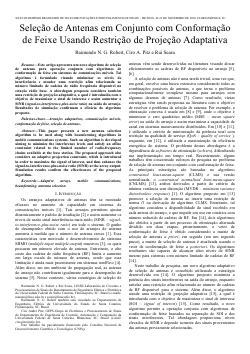
Seleção de Antenas em Conjunto com Conformação de Feixe Usando Restrição de Projeção Adaptativa
Raimundo Robert, Ciro André Pitz, Rui Seara
DOI: 10.14209/SBRT.2020.1570649611
Keywords: Arranjos adaptativos Comunicações móveis Conformação de feixe Seleção de antenas
Abstract
Este artigo apresenta um novo algoritmo de seleção de antenas para operação conjunta com algoritmos de conformação de feixe em sistemas de comunicações móveis. Tal algoritmo é formulado visando minimizar os níveis de interferência e atender uma restrição afim relacionada ao número limitado de cadeias de rádio frequência disponível na estação rádio base. A abordagem proposta considera também uma restrição de projeção adaptativa, a qual é introduzida com o objetivo de maximizar o sinal de interesse e assim aumentar a SINR (signal-to-interference-plus-noise ratio) na saída do arranjo. Resultados de simulação confirmam a eficácia do algoritmo proposto.Download

Comparando métodos para determinar a distribuição de uma carteira de investimentos em renda variável
Giovani Viana, Miguel Guedes, Gustavo Sandri
DOI: 10.14209/SBRT.2020.1570649629
Keywords: diversificação distribuição investimento
Abstract
Neste trabalho comparamos três métodos para se determinar a distribuição de uma carteira de renda variável: método Ingênuo onde todas as ações possuem o mesmo peso, Teoria Moderna dos Portfólios e por Referência. O último método foi proposto por nós. Ele tenta replicar o comportamento de uma carteira pulverizada utilizando poucos ativos e foi o que apresentou a melhor performance quando comparado aos outros dois.Download